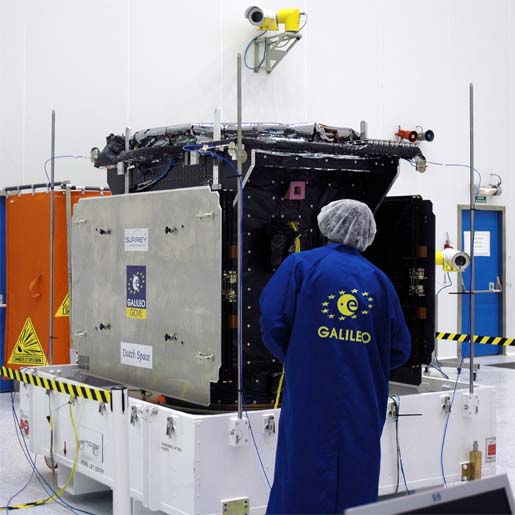The GPS program has taken a fiscal hit that will delay critical plans to begin multi-satellite launches and could ultimately hamper the Air Force’s ability to keep the constellation at its current level of service.
The shortfall is just one of the challenges facing the program over the next four months as the current six-month budget extension winds down, the government’s ability to borrow runs out, and, barring a fast political deal, the onerous budget cuts set up under sequestration kick in.
The GPS program has taken a fiscal hit that will delay critical plans to begin multi-satellite launches and could ultimately hamper the Air Force’s ability to keep the constellation at its current level of service.
The shortfall is just one of the challenges facing the program over the next four months as the current six-month budget extension winds down, the government’s ability to borrow runs out, and, barring a fast political deal, the onerous budget cuts set up under sequestration kick in.
The immediate concern is a decision by Congress to deny a request to shift $20 million to support the development of dual launch — the capability to launch two GPS III satellites at a time.
In its Omnibus 2012 Implementation, a collection of requests to reprogram funding in various accounts, the Department of Defense (DoD) asked to move $20 million in order to “design and develop Global Positioning System (GPS) dual launch capability for the Evolved Expendable Launch Vehicle Fleet.”
A source familiar with the matter said the money was to have come from the GPS III program. Indeed, the long list of funding cuts DoD was proposing included a $20 million cut from GPS III.
The funding, the request noted, would “help the (GPS) program meet the National Launch Forecast requirements,” an acknowledgement of a key program challenge. As reported earlier this year, the GPS program is fast approaching a critical period when aging satellites and a limited number of available launchers are expected to make maintaining the constellation problematic.
The earliest GPS satellites were launched in clusters as the constellation was being built out. Should similarly aged satellites start to fail in rapid succession, it could necessitate the rapid replacement of multiple spacecraft.
However, only a limited number of Evolved Expendable Launch Vehicles (EELVs), the rocket used to loft GPS satellites, are available, and the demand for them is expected to escalate, driven in part by the needs of other federal satellite programs. Experts suggested a shortage of launchers could occur in the 2015–2016 timeframe. Dual launch was seen as one way to ease the launch crunch — and save some $50 million per satellite in launch costs.
“Depending on when you start dual launch, and how many satellites you do with dual launch over the GPS III constellation deployment cycle, that could result in anywhere from $700 million to $1.5 billion in savings,” said Lockheed Martin spokesman Michael Friedman.
Friedman said that Lockheed Martin had already completed a study that showed it was possible to launch two GPS III satellites onboard an Atlas 5. In the next round of studies Lockheed would design a dual-channel communications unit, which would allow the ground system to distinguish between the two satellites during launch and on-orbit insertion.
Meanwhile, the United Launch Alliance was to continue design work on the Dual Satellite System Payload Adapter, which would keep the two satellites safe as they are launched and placed in orbit. ULA did not respond to a request for a comment.
Congressional Intervention
Dual launch is now considered part of the program’s baseline, according to the omnibus implementation request, and the Defense Department has been working on it for some time. And, as far as Congress was concerned, that was the problem.
Inside GNSS was told that Congress gave no official reason for denying the reprogramming request. A Democratic staffer, however, speaking on condition of anonymity, said the request was denied because it was not appropriate to submit it under reprogramming.
“The [Appropriations] Committee has had concerns about budgeting practices in the Department of Defense for several years,” the staffer said in an email, “including the practice of seeking reprogrammings for items that should appear in the annual budget request to Congress. The reprogramming process is directed by law to apply only for higher priority, unforeseen military requirements.“
“The Department’s proposal to develop a GPS dual-launch capability has been in works for some time, and is not an unforeseen requirement,” the staffer added. “We have informed the Air Force about the reasons for our objection to funding this program outside the normal budgeting process, and that the Committee will re-examine the program in future budget requests, especially in light of the high cost of space launch.”
The staffer’s point was echoed in the report accompanying the Senate defense appropriations bill. Senate appropriations criticized DoD for lax oversight and expressed concern about “above threshold reprogrammings.”
“The Committee understands fact of life changes will occur after the budget is approved by Congress,” it wrote in S. Report 112-196, “and provides significant flexibility in general and special transfer authority to account for these unanticipated changes. However, the number of reprogrammings, dollar amounts, and significant increase of requests to start new programs outside the normal budget cycle that do not receive the same level of oversight, scrutiny and documentation, is disconcerting.”
The Air Force is seemingly taking the point to heart and does not plan to resubmit the request in the 2013 list of reprogrammings.
“The next opportunity for the Air Force to request funds is via the FY14 President’s Budget,” said a Directorate of Space Programs official.
Dual launch was baselined to begin with the 9th and 10th GPS III space vehicles (SVs), said Friedman. SV9 was slated for launch in the 2019 timeframe. The Air Force and its contractors have been working to improve that schedule and were striving to be able to dual launch the SV5 and SV6 — which were tentatively slated to be launched in 2017.
“The FY12 Omnibus request for $20M was to begin the effort to develop the dual launch capability for GPS III satellites on EELV in 2013,” said the Directorate official. “The denial of the $20M will delay the beginning of the development effort.”
Whatever the delay, dual launch will happen because it has to, said one insider who spoke on condition of anonymity.
“It makes a huge difference being able to launch two (satellites) on one (rocket)” in terms of the cost, the expert said, adding that “because the number of launchers are not going to be the numbers that they want,” if they don’t have dual launch “they can’t sustain the constellation.”
Other changes
In addition to the dual-launch funding, the undated omnibus reprogramming document had a number of other requests to shift monies in GPS-related programs.
Congress approved a $32 million cut to the Army’s purchase of Defense Advanced Global Positioning System Receivers (DAGRs). The savings come from both a smaller order for the devices and a reduction in unit price, according to the notes that accompany each request. The contractor, however, “was able to maintain an economic order quantity of 13,500 devices,” it says.
There were also two requested cuts to research and development work that could be applicable to GPS. The first, a $9 million cut to Air Force Research, Development, Test, and Evaluation would have affected unspecified navigation technologies. The other, a $15 million cut to Advanced Technology Development, would have undercut work on low-cost space power generation. Both requests were denied.
Continuing . . . and Continuing . . .
The omnibus reprogramming request should not be confused with the omnibus funding bill Congress is still working on. They passed instead a $1.047 trillion continuing resolution that will keep the government operating until the end of March.
Like many stop-gap funding bills that preceded it, Continuing Appropriations Resolution, 2013 or H. J. Res. 117, largely keeps the funding levels for fiscal year 2013 at the levels of FY12. The actual funding levels for the GPS program and for the Federal Aviation Administration (FAA) contribution for civil elements in the GPS modernization efforts are not yet clear.
The National Coordination Office (NCO) for Space-Based Positioning, Navigation and Timing will be working with $770,000 this year – just slightly lower than the amount the office had to work with the year before, according to NCO Director Tony Russo.
Operating under a continuing resolution (CR), however, entails a number of challenges. These include generally sharp limits on new starts – that is, the launch of new projects or procurements. New studies on interference issues could be caught up, for example, or procurements could be delayed.
The rules, however, vary from department to department, said Stan Collender, a federal budget expert, which makes it hard to anticipate the impact on any specific program or agency. Collender is a partner and global director of financial communications at Qorvis Communications LLC.
That same department-by-department variation applies to other things as well. Payments, for example, may be delayed.
“The FAA usually will not start the process of sending money until we are out of the CR,” noted one expert, “and as you know the CR can go pretty well into the [fiscal] year.”
Particularly problematic for the GPS program is the fact that Congress chose to continue funding at current levels. The program needed to make up ground lost over the last two years when Congress cut tens of millions of dollars from the FAA’s request for the civil funding.
In FY11 Congress cut $20 million from a request for $58.5 million. In FY12 FAA won approval for just $19.0 million of the $50.3 million it requested — a total shortfall of some $50 million.
In FY11 the cut was seen as a temporary program adjustment because the program had run into some delays, explained a source familiar with the program at the time.
As long as the money was restored in a future fiscal year, it would not have been a problem. That did not happen in FY12, and now it appears increasingly unlikely, given both the CR and the prospect of sequestration.
Will the Ax Fall?
Sequestration, a set of mandatory and indiscriminate budget cuts, was part of a hard fought compromise last summer to keep the government from running out of money. The nation had hit its debt ceiling in May and, unable to borrow more money, Treasury had been using some financial sleight of hand to keep the doors open.
Those options were drying up by the end of July, and the federal government was facing a crisis. Republicans, however, refused to raise the debt limit unless broad budget cuts were found.
With time running out and the financial markets watching, the White House and Congress agreed to make $2.4 trillion in spending cuts over the coming decade. Of that $900 billion would be made immediately and a bipartisan “super-committee” would be set up to work out the rest.
To ensure the committee’s success the deal included a particularly nasty set of budget cuts that would be triggered automatically unless the group worked out a plan and Congress passed it. The idea was to make the consequences of failure so appalling that the committee would absolutely have to come to agreement.
It didn’t work.
The committee could not settle on the source of the needed savings and now, without an agreement before the end of this year, more than $100 billion dollars will be cut from government operations in 2013 — some $55 billion of it from defense.
Across the Board
It isn’t just that cuts are coming if sequestration is imposed; it is how the cuts will be made. All nonexempt programs would take the same percentage cut.
“There is very, very, very little discretion for an agency. . . . [I]t is supposed to be across the board,” said Collender. “You’re not supposed to be able to save one (program) and cut another one by more to compensate.”
Indeed, a glance at a September report by the Office and Management and Budget reveals page after page of 7.6 to 9.4 percent cuts across Congress, the judiciary, and nearly every agency including FAA, defense, and the National Telecommunications and Information Administration (NTIA).
Collender does not think that enough time remains before the first week in January, when the cuts take effect, to work out a deal. He said that is not a critical issue because there are ways to ease into sequestration if it happens.
“There is a procedure that the Office of Management and Budget can use known as apportionment that can be used by agencies, DoD and others, to avoid cuts at the beginning of January,” he explained. “It doesn’t mean that the cuts won’t eventually happen, if sequestration stays in place, but it means that the immediate impact on DoD or any of the other departments and agencies could be relatively limited, especially if they think that there is going to be some sort of resolution at some point in January.”
One important note: sequestration was an element of the deal made last year when the debt ceiling needed to be raised. Treasury has said that the nation will need to raise the debt ceiling yet again, sometime around the first of the year.
It appears that the White House and Congress agree with Collender — that it is too late to work out a full deal. Press reports indicate that a compromise is emerging where a limited number of cuts would be made immediately with a much more comprehensive deal to be worked out after January 1.
Delay entails a risk though, noted Collender, who pointed out that by the time New Year’s Day rolls around the government is well into its fiscal year.
“On January 1 you are already three months into the fiscal year. So, you are now going to take a full year of cuts in nine months,” he said. “If you wait another month before implementing, you are going to take a full year’s reduction in only eight months. That means that the percentage is going to be much, much greater.”
The Silver Lining
As for the prospects for GPS in general and dual launch specifically, every source who spoke to Inside GNSS noted the support GPS enjoys in the Defense Department and on both sides of the aisle. The program will face the same budget pressures as the rest of the government, however, and GPS managers will not get all of the money they want.
Even so, one insider was confident that the effort to develop dual launch will go forward even if it is delayed, because the Air Force needs the cost savings and the expanded launch opportunities.
“Dual launches for GPS will happen,” asserted the expert. “It is just a matter of when.”






